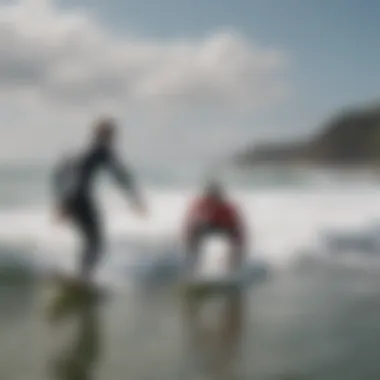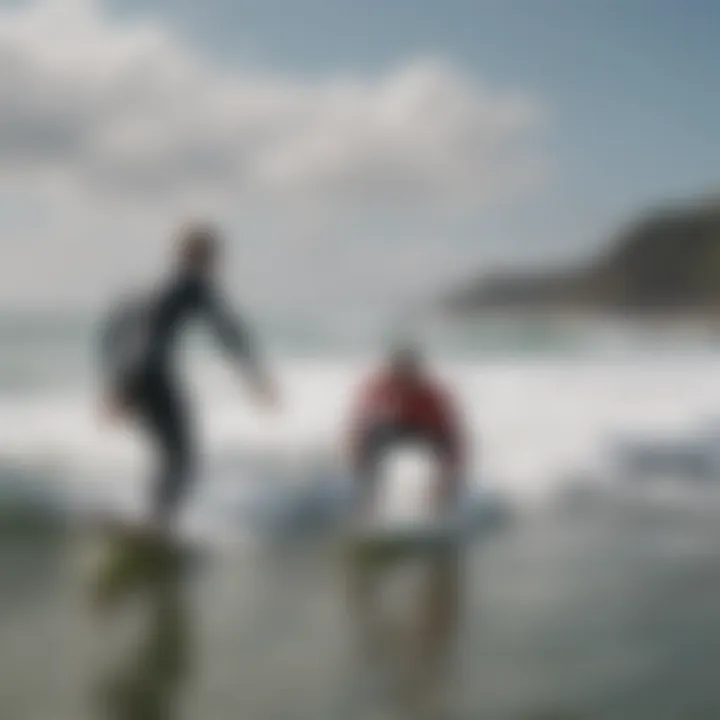Exploring Adapted Surfing: Innovation in Watersports


Intro
Adapted surfing stands at the intersection of sport and inclusivity, making waves in the watersports community. As we delve into its world, we discover how this activity transforms lives, fosters resilience, and builds a vibrant community. The door to the ocean swings open wider with each innovation, allowing everyone — regardless of ability — to embrace the thrill of riding waves.
The essence of adapted surfing goes far beyond just riding a board on the water. It’s about connecting with nature and oneself, breaking barriers, and creating a space where everyone feels they belong. The evolution of equipment, training methodologies designed for diverse capabilities, and events aimed at promoting inclusivity are just some of the threads woven into this inspiring narrative.
Key points to explore include the technical modifications in surfboards and gear, the psychological benefits that extend beyond the surf, and the community initiatives that support aspiring surfers. We'll also highlight some impactful stories from participants whose lives have been dramatically changed through adapted surfing, demonstrating that the ocean is not merely a body of water, but a gateway to empowerment and connection.
In examining the landscape of adapted surfing, we will move broadly into the Gear Recommendations section, where we will pinpoint essential equipment for newcomers to the sport, followed by advanced gear options for seasoned surfers. Each piece of equipment plays a vital role in not just safety, but enhancing the surfing experience itself.
Understanding Adapted Surfing
In a world where waves are often seen as a playground exclusively for the able-bodied, adapted surfing emerges as an empowering force, bending these long-held perceptions. It goes beyond mere sport; it's an innovative approach to making the ocean accessible for all, regardless of their physical or cognitive abilities. Understanding adapted surfing is crucial, as it encapsulates the core elements that facilitate participation in such a dynamic activity. This section will dive deep into what constitutes adapted surfing, how it has transformed over time, and why these developments matter for athletes, outdoor enthusiasts, and community advocates alike.
Definition and Principles
Adapted surfing refers to surf-related activities tailored to accommodate individuals with various disabilities. It encompasses a wide range of approaches and innovations designed to ensure that everyone, no matter their physical limitations, can experience surfing. The principles of adapted surfing rest on inclusivity and innovation, focusing on breaking down barriers that could prevent people from engaging with the sport. Essential to this practice is a commitment to safety, empowerment, and fun, showcasing that the joy of riding waves is not limited to just those who meet traditional athletic standards.
Here are some of the fundamental elements of adapted surfing:
- Equipment Modification: Adaptive surfboards are personalized to meet the needs of different surfers. This may include wider boards for better stability, specialized seating for those who cannot balance on their own, or custom foot straps to keep surfers securely in place.
- Individualized Instruction: Tailored training sessions help surfers learn at their own pace, ensuring they grasp both foundational skills and advanced techniques, while also accommodating any specific needs they may have.
- Community Engagement: Adapted surfing fosters community by bringing together individuals from diverse backgrounds. It breaks down social barriers and promotes inclusivity, allowing participants to form lasting friendships and supportive networks.
Historical Context
The journey of adapted surfing traces back to the late 20th century, gaining momentum as awareness about disabilities and the importance of inclusivity began to rise. In the early days, the sport faced significant challenges, often overlooked by traditional surfing communities. However, pioneering individuals and organizations started advocating for adaptive methods and equipment, recognizing that the thrill of catching a wave should be a universal experience.
The emergence of specialized surf programs in places like California and Australia provided the initial push towards acceptance. They demonstrated that with the right tools and environment, individuals with disabilities could not only surf but excel at it. These pathfinders laid the groundwork for modern adapted surfing, developing a network of resources that continues to expand today.
From surf therapy programs to national competitions, the evolution of adapted surfing paints a picture of resilience and innovation. As more organizations and local initiatives pop up worldwide, adapted surfing is not just about riding waves; it's about riding the wave of change, fostering new opportunities for everyone willing to try.
"Adapted surfing offers the chance to transcend barriers, unite communities, and open doors to a world previously thought inaccessible."
The Importance of Adapted Surfing
Adapted surfing stands at the confluence of sport and social responsibility, addressing a substantial gap in the world of water sports. It isn't just about riding waves; it’s about creating opportunities for everyone, regardless of physical abilities or limitations. Recognizing the importance of adapted surfing involves understanding its multifaceted benefits that extend into physical health, mental well-being, and the fabric of community life.
Enhancing Physical Health
Engaging with adapted surfing can have remarkable effects on physical fitness. For individuals with disabilities or mobility challenges, the water provides a unique environment that encourages movement without the constraints typically found on land. Surfing is a full-body workout, promoting muscle strength and enhancing cardiovascular health.
- Core Strength: Balancing on a surfboard requires significant core stability, which helps improve overall strength and posture.
- Flexibility: Navigating the waves encourages flexibility, particularly in the hips and shoulders.
- Endurance: Paddling in the ocean builds stamina, allowing participants to engage longer in physical activity.
For instance, individuals who may struggle with conventional exercise can find joy in the rhythm of the ocean, often leading to better health outcomes overall. Real-life stories reveal that many surfers have noticed improvements in their mobility and strength after incorporating adapted surfing into their routines.
Psychological Benefits
The psychological impacts of surfing go beyond just having fun in the waves. Adapted surfing presents an avenue for participants to tackle mental health challenges. The ocean has a well-established reputation for reducing stress and anxiety. For those with physical disabilities, this connection to nature can be even more profound.
- Boosting Confidence: Successfully catching a wave can significantly enhance self-esteem and a sense of accomplishment.
- Social Engagement: Water sports like surfing foster friendships and camaraderie, which are crucial for mental health.
"Surfing provides not just freedom on the water, but peace of mind on land."
Many practitioners report a reduction in feelings of isolation, often citing the supportive community around adapted surfing as a crucial factor in their mental wellness. Events and group sessions can break down barriers, creating connections that cultivate resilience.
Social Inclusion and Community Building


At its core, adapted surfing promotes inclusivity. It is a powerful tool for social change that champions the idea that everyone should have the opportunity to experience the joy of surfing, regardless of their circumstances. By participating in adapted surfing programs, individuals can find acceptance and support among diverse groups.
- Community Events: Competitions and group surfing lessons bring together enthusiasts from all walks of life, creating networks of support and camaraderie.
- Awareness and Education: Through events and outreach, adapted surfing helps break stereotypes, opening dialogues about disabilities and abilities alike.
As more communities adopt adapted surfing, we witness a ripple effect that fosters acceptance and empathy toward individuals with different abilities. The shared experience of facing challenges on the waves brings people together, fostering relationships that last beyond the surf.
In summary, the importance of adapted surfing transcends mere sport; it lays the groundwork for health, empowerment, and community.Arise opportunities and shape a culture where anyone can ride the waves is pivotal in promoting a better understanding of ability and inclusivity.
Innovative Equipment for Adapted Surfing
When we think about surfing, many of us picture a carefree, sun-drenched day at the beach. However, for people with disabilities, the sport can seem daunting. This is where innovative equipment plays a game-changing role. The adaptation of surfboards and gear not only makes the sport feasible for a wider range of participants but also enhances the entire experience, boosting confidence and allowing for greater freedom in the water.
Adaptive Surfboards
Design Features
Adaptive surfboards are a critical cornerstone in making surfing accessible. Their unique design characteristics set them apart from standard surfboards. Often, these boards are wider and have a more stable base, allowing for better balance and control. This is particularly beneficial for individuals who may not have the same core strength or coordination as traditional surfers.
Moreover, many adaptive surfboards come with specialized fin systems that provide improved grip on the water. The increased stability translates to a more enjoyable ride, thus encouraging those with disabilities to push their limits in a supportive setting. Customizing features to fit individual needs is what makes these boards a real gem in adapted surfing.
Custom Modifications
Custom modifications to surfboards take accessibility to the next level. With these adjustments, boards can be tailored—whether through altering the shape, weight distribution, or adding support elements. Such changes are not merely cosmetic; they reflect the individual needs of surfers, allowing for a smoother transition from land to sea.
For instance, some modifications come in the form of adjustable foot straps or cushioned seating options for surfers with mobility challenges. These small touches can make a significant difference in comfort and safety, often turning fear into exhilaration when riding a wave. Custom modifications can be vital, as they can be designed to fit various disabilities, ensuring that surfing is a sport for everyone.
Safety Gear
Life Vests and Floats
Safety gear is indispensable in adapted surfing, ensuring not only the safety of participants but also peace of mind for instructors and families. Life vests tailored for those with disabilities often feature enhanced buoyancy and fasteners that secure snugly without sacrificing comfort.
This customized protection element allows individuals to focus on their technique and enjoyment rather than worrying about their safety. Many life vests even come with integrated flotation aids, offering additional support that leads to a more relaxed experience while surfing.
Adaptive Swim Aids
Adaptive swim aids represent another layer of safety, allowing surfers to gain confidence in the water. These aids can include flotation devices, buoyancy belts, or even specialized flotation seats that maintain stability while paddling. The value here is clear: when surfers know they can rely on their equipment, their overall mental well-being improves along with their surfing skills.
Consideration of swim aids is crucial, as they are often the difference between a frustrating experience and one of pure joy. They enable individuals with limited mobility to engage effectively in watersports, thereby reinforcing the core philosophy of inclusivity in surfing.
"Innovations in surf gear redefine the bounds of what's possible, bringing joy to many by making the ocean more accessible."
Training for Adapted Surfing
Training in adapted surfing is crucial, not just for the skills needed to ride the waves, but for the holistic benefits it offers to participants. Surfing is inherently dynamic, requiring adaptability and skill. This limited accessibility in traditional surfing can deter individuals with disabilities. Through targeted training, however, these barriers can be lowered, allowing individuals to experience the thrill of the ocean.
The Role of Surf Instructors
Surf instructors are pivotal in adapted surfing. Their expertise goes beyond basic surfing skills; they must understand the unique needs of every participant. Not all instructors are created equal. The ones specializing in adapted surfing often undergo additional training that focuses on empathy and communication skills, enabling them to connect with diverse abilities and backgrounds. Instructors should be like guides, not just teaching how to balance on the board, but also fostering a supportive atmosphere. A good instructor encourages not only technical mastery but ultimately builds confidence and a sense of belonging.
Tailored Training Programs
Tailored training programs focus on customizing the learning experience based on individual abilities and goals. This ensures that everyone gets the most out of their time in the water. This could mean adapting lessons to enhance physical abilities, or it might involve creating a supportive and encouraging environment.
Assessment of Individual Needs


Assessment of individual needs is fundamental in tailored training programs. It's about understanding both the strengths and limitations of a participant. By assessing physical capacities, motivations, and even emotional readiness, instructors can develop a personalized approach that aligns with each learner’s unique circumstances. This process is beneficial because it sets a solid foundation, ensuring that the training is relevant and effective. By emphasizing this tailored aspect, instructors can address specific challenges that participants might face, leading to more engaging, productive sessions.
Some unique features of this assessment include:
- One-on-one evaluations
- Setting realistic, attainable goals
- Continuous feedback loops
While this approach puts emphasis on the individual, it can require additional time and resources from instructors, which might not be readily available everywhere.
Skill Development Techniques
Skill development techniques play an essential role in furthering the training process in adapted surfing. These techniques not only cover the physical aspects of surfing but also nurture psychological resilience. Not all individuals will advance at the same pace, so methods need to be diverse and adaptable. Key characteristics of skill development techniques include:
- Incremental skill-building
- Use of visual aids and demonstration
- Incorporating games and drills for retention
These methods empower participants by instilling a sense of achievement in their capabilities. A solid feature of these approaches is their focus on positivity and progress, which helps in creating motivating environments. However, finding the right balance of intensity and comfort can prove challenging sometimes. Instructors need to be perceptive to gauge how participants respond to various techniques, adjusting as necessary to sustain engagement.
The true essence of training for adapted surfing lies in its ability to transform limitations into strengths.
In summary, training for adapted surfing is an intricate web of tailored assessments, innovative training techniques, and the invaluable support of skilled instructors. This intricate process not only prepares individuals for the waves ahead but also cultivates a community of resilience and connection.
Mental Health Aspects of Adapted Surfing
In recent years, mental health has garnered significant attention, and rightly so. When it comes to adapted surfing, the mental health aspects cannot be ignored. Surfing isn't merely a physical activity; it is an experience that engages the mind and spirit as much as it does the body. For those with disabilities or differing abilities, the act of surfing can unlock a treasure trove of psychological benefits, paving pathways to resilience and emotional healing.
Building Resilience
There’s a saying that goes, "What does not kill you makes you stronger," and that rings especially true for individuals who participate in adapted surfing. The process of learning to surf, facing waves, and even the occasional wipeout, builds resilience in ways few other activities can. Each wave presents a challenge – some days the sea is calm, other days it roars.
As participants hone their skills, persistence becomes second nature. Through both triumphs and setbacks, they learn to maneuver not only the surfboard but also the trials and tribulations of daily life. This robust tenacity often translates beyond the ocean, positively impacting their overall mental well-being. It fosters a mindset that embraces challenges, encouraging individuals to tackle life’s hurdles with renewed vigor.
Therapeutic Benefits of Surfing
Surfing can be likened to a therapeutic balm for many. The rhythmic sound of the ocean, the feel of saltwater on the skin, and the adrenaline of riding a wave all work together to create a therapeutic environment. Scientifically, there’s evidence that spending time in water can elevate mood, reducing anxiety and stress levels significantly.
Moreover, adapted surfing programs often incorporate mindfulness practices. Participants are encouraged to focus fully on the present moment, relishing the sensation of floating atop the water and the thrill of catching a wave. This mindfulness helps to quiet the mind, providing a necessary respite from the noise of everyday life.
"In every wave, there’s a chance for renewal."
In essence, adapted surfing fosters a unique blend of physical exercise, social interaction, and mental engagement. It’s not just fishing for good vibes; it’s pulling them in full throttle. The community built around these activities offers support, understanding, and shared joy, enhancing the therapeutic aspects even further.
To sum it up, the mental health benefits of adapted surfing are profound and varied. From building resilience to promoting therapeutic benefits, surfing represents a holistic approach to improving life quality. Embracing the waves leads to a cascade of positive outcomes that reach far beyond the shores.
Showcasing Adapted Surfing Events
Showcasing adapted surfing events plays a pivotal role in promoting inclusion and awareness in watersports. These events not only highlight the remarkable abilities of surfers with disabilities but also bring communities together, breaking down barriers and fostering mutual respect among participants and spectators. By creating platforms where athletes can demonstrate their skills, adapted surf events invigorate the conversation around accessibility in sports, encouraging future innovations and wider acceptance.
Competitions and Demonstrations
Adapted surfing competitions are more than just contests; they represent a powerful statement about what dedication and courage can achieve. Competitions often attract a diverse audience, showcasing inspiring stories of resilience and tenacity. For instance, events like the World Adaptive Surfing Championships provide a stage for surfers of various abilities—from those utilizing prosthetics to surfers relying on adaptive paddles.
These competitions usually involve different categories, ensuring each participant can compete in a fair environment. Events often include:
- Stand-Up Adaptive Surfing: For those who can balance on a board.
- Prone Surfing: For participants who lay on the board.
- Sit Surfing: For individuals who remain seated on specially designed surfboards.
Competitors receive support not only from their coaches but also from peers, strengthening the community spirit. The atmosphere is electric as cheers rise from the crowd, reinforcing the notion that surfing knows no limits. Each wave caught or crash against the shore turns into a lesson in courage. As people witness these events, it becomes clear that surfing is a language everyone can understand, one spoken through waves and shared experiences.


Raising Awareness through Events
The importance of adapted surfing events extends beyond the participants themselves. Events serve as a vital conduit for raising awareness about the capabilities of individuals with disabilities and the adaptability of the sport. Engaging local and international media fosters broader discussions, shifting perceptions around what athletes can achieve.
These events often incorporate workshops and demonstrations, where attendees can learn about:
- Adaptive Equipment & Technology: Insights into what makes contemporary boards and gear suitable for all abilities.
- Training Techniques: Sharing knowledge on how instructors can adapt their methods for diverse needs.
- Guidelines for Safety and Inclusion: How to safely engage individuals with varying physical capabilities in water sports.
"Adapted surfing events are a reminder that the ocean belongs to everyone."
Such initiatives spark interest in local communities, often leading to increased participation in watersports among individuals who may have previously thought they couldn't participate. Through strategic partnerships with schools, non-profit organizations, and local businesses, these events generate a ripple effect, encouraging new programs that support adapted watersports.
By attending and supporting adapted surfing events, people learn about the importance of accessibility in sports. These events leave a lasting impression, building momentum towards a more inclusive future in surfing and beyond.
Community Support and Resources
In the realm of adapted surfing, community support and resources play a pivotal role in creating an environment where individuals, regardless of their abilities, can engage in watersports. This section will delve into various aspects of community support, emphasizing the significance of organizations and local initiatives that foster inclusivity and provide necessary tools and aid for participants.
Organizations Promoting Adapted Surfing
Numerous organizations have emerged, devoted to promoting adapted surfing and engaging a wider audience. These entities serve as beacons of hope and empowerment, ensuring that surfing is not an exclusive domain but one where everyone can catch a wave. Organizations such as the Surfing for the Disabled, Waves of Impact, and Adaptive Surf Project are at the forefront, focusing on providing opportunities, resources, and community connections.
- Surfing for the Disabled: This organization operates on the philosophy that surfboards and waves should be accessible to all. They conduct regular classes that cater specifically to individuals with disabilities. This inclusive approach creates an atmosphere where everyone feels welcomed and supported.
- Waves of Impact: Known for its engaging programs, Waves of Impact organizes surf camps that allow participants to experience the joy of surfing while being mentored by trained instructors. These camps not only provide surfing skills but also integrate social elements, fostering friendships and camaraderie among participants.
- Adaptive Surf Project: Dedicated to spreading awareness and providing resources, the Adaptive Surf Project works tirelessly to connect enthusiasts to local programs. They focus on advocating for inclusivity and better accessibility in surf spots, ensuring individuals with disabilities can safely enjoy the ocean.
These organizations are crucial in cultivating a supportive network. They not only adapt surfing experiences but also raise awareness about the potential of adaptive sports in general.
Local Initiatives and Programs
On the grassroots level, local initiatives hold immense value in the promotion of adapted surfing. Programs tailored to specific communities resonate deeply, bridging gaps and reinforcing connections through shared passion.
- Neighborhood surf schools often offer adaptive programs, utilizing local surf culture to inspire participation. In places like California and Hawaii, many surf schools have introduced adaptive lessons, incorporating specialized equipment and trained instructors.
- Surf Camps designed specifically for individuals with disabilities are becoming common. Local examples might include Surfable Adventures in San Diego, where they provide all-day surf camps tailored to meet individual needs, breaking down logistical barriers that often prevent participation.
- Community events such as beach clean-ups followed by surf sessions are also integrated into adaptive surfing culture. These activities unify communities, offering an opportunity to enjoy the waters while promoting environmental stewardship.
An often underappreciated benefit of local initiatives is their ability to foster relationships among participants and volunteers. Grassroots efforts create a sense of belonging that extends far beyond the surfboard.
"The waves might be the same, but our experiences on them can transform lives.\n - Anonymous
Future Outlook for Adapted Surfing
In the dynamic landscape of sports, adapted surfing stands as a beacon of inclusivity and opportunity. As we look toward the future, the evolution of this discipline hinges on a couple of pivotal components: technological advancements and community advocacy. These aspects not only underline the importance of accessibility but also propel the sport toward new heights, ensuring that an increasing number of individuals can experience the joy of surfing.
The future promises to integrate groundbreaking innovations, addressing the specific challenges faced by surfers with disabilities. We are at a crossroads where the contributions of various stakeholders—engineers, surf instructors, and enthusiasts—coalesce to create a more inclusive environment. With the right encouragement and resources, the world of adapted surfing can flourish, enriching lives and shaping perceptions in surf culture.
Innovations on the Horizon
The call for innovation in adapted surfing is growing louder, driven by both necessity and passion. Here are some exciting trends to watch for:
- Smart Surfboards: Imagine surfboards equipped with sensors that monitor water conditions and provide feedback to the rider in real-time. These boards could sense waves and adjust feedback specifically tailored for individuals with sensory impairments.
- 3D Printing: As additive manufacturing becomes more prevalent, custom surfboards tailored for each individual's physique can be produced easily. This will enhance both safety and performance for surfers needing specialized designs.
- Wearable Technology: Devices that track physical exertion or provide communication links between instructors and surfers could become standard. This can be particularly beneficial for those who have mobility challenges.
"As technology continues to advance, the barriers that once limited access to surfing are slowly crumbling. It’s not just about riding a wave; it’s about rewriting the narrative of what it means to be an athlete."
Each of these innovations represents a leap toward making surfing an enjoyable and accessible sport for everyone. Moreover, they embody the spirit of creativity and resilience that defines adapted surfing.
Advocacy for Inclusion
Awareness and advocacy play a crucial role in the journey toward a more inclusive surfing community. There are several vital considerations that emerge:
- Community Engagement: It's essential that local surfing clubs actively involve people with disabilities in planning and organizing events. This increases visibility and normalizes adapted surfing within the broader community.
- Policy Changes: Advocating for inclusive policies on beaches, such as wheelchair access and specialized surf instruction, can create a more welcoming environment for everyone. It's about ensuring that the very spaces where we surf reflect a commitment to diversity.
- Education and Training: Instructors and clubs should be educated about the unique needs of adapted surfers. This training includes recognizing potential barriers and learning to provide appropriate support.
- Role of Organizations: Non-profits and community organizations that focus on adaptive sports are pivotal. They often lead initiatives to educate the public and promote events where surfers can showcase their skills.
- Building Awareness: Events specifically aiming to attract attention to the capabilities of adapted surfers can have sizeable ripple effects. Think of competitions that not only put surfers on display but also invite spectators to experience the energy and fervor associated with the sport.
In closing, it is this advocacy that will steer the future of adapted surfing. By fostering an inclusive culture both on and off the water, we can ensure that surfing remains a sport that embraces everyone, regardless of their abilities.















